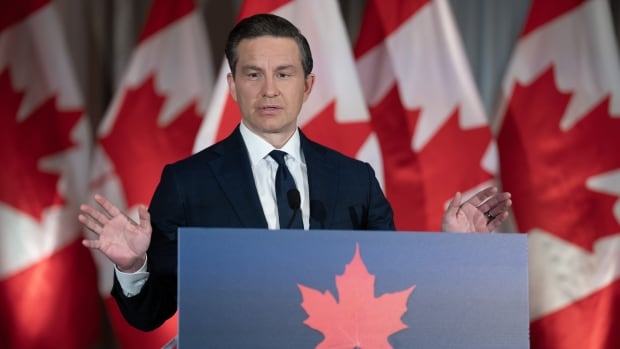Politics
Poilievre Demands Strict Immigration Limits for Better Integration

Pierre Poilievre, the leader of Canada’s Conservative Party, has called for a significant reduction in immigration numbers, advocating for “very hard caps” on new arrivals to the country. During a news conference on October 23, 2023, in Ottawa, Poilievre expressed concerns over the integration of newcomers, stating that Canada should prioritize having more individuals leave than enter in the coming years.
He emphasized the urgency of the situation, noting that millions of temporary permits are set to expire within the next few years, which will likely result in many foreign residents departing. “We need more people leaving than coming for the next couple of years,” he stated. Poilievre has been critical of the previous Liberal government’s approach to immigration, which he labeled as ineffective during the last election campaign. He pledged to “restore order” to what he described as a “broken” immigration system.
Calls for Negative Net Migration
At the press conference, Poilievre did not specify exact numbers for the proposed immigration caps. Nevertheless, he reiterated his campaign promise to “dramatically” decrease the number of temporary foreign workers and international students. He suggested that Prime Minister Mark Carney should implement even stricter measures, including a target for negative net migration.
Immigration has become a central theme in Poilievre’s public remarks and social media messaging following the recent election. He highlighted the challenges posed by elevated immigration levels, which have contributed to significant population growth in Canada. According to Statistics Canada, the Canadian population grew by 2.5 percent in 2022 and 3.1 percent in 2023, rates that are double or even triple those seen in previous years.
During a recent appearance at the Calgary Stampede, Poilievre criticized the Liberal government’s immigration policies, referring to them as a “failed experiment with open borders.” He argued that immigration numbers must be manageable to ensure that newcomers can be effectively integrated into society.
Impacts of Population Growth
The surge in Canada’s population, which has increased by approximately 3.6 million since early 2020, has largely been fueled by non-permanent residents, including students and low-wage foreign workers. This rapid growth has led to various pressures on the Canadian economy, including record-low rental vacancy rates, rising housing prices, and elevated unemployment among youth and immigrants.
In response to these challenges, the previous Liberal government attempted to reduce the number of international students and temporary foreign workers. Recent data from Statistics Canada indicates that the population growth rate was 0.0 percent in the first quarter of 2023, marking the second consecutive quarter with a net decrease in non-permanent residents.
Carney has committed to maintaining limits on non-permanent residents, aiming to cap their numbers at five percent of the total population by the end of 2027. This would represent a significant decrease from the current figures, which estimate around 3 million non-permanent residents in Canada, translating to approximately 7.5 percent of the total population of about 40 million.
The proposed reduction in the number of international students and temporary workers, if fully implemented, could impact businesses that rely on foreign labour. Poilievre insists that immigration policies must focus on admitting “the right people in the right numbers” to prioritize the needs of Canadians.
As discussions around immigration policy continue, the Conservative leader’s stance underscores a growing debate within Canada about how best to balance economic needs with the integration of newcomers.
-

 Politics4 weeks ago
Politics4 weeks agoSecwepemc First Nation Seeks Aboriginal Title Over Kamloops Area
-

 World5 months ago
World5 months agoScientists Unearth Ancient Antarctic Ice to Unlock Climate Secrets
-

 Entertainment5 months ago
Entertainment5 months agoTrump and McCormick to Announce $70 Billion Energy Investments
-

 Science5 months ago
Science5 months agoFour Astronauts Return to Earth After International Space Station Mission
-

 Lifestyle5 months ago
Lifestyle5 months agoTransLink Launches Food Truck Program to Boost Revenue in Vancouver
-

 Technology3 months ago
Technology3 months agoApple Notes Enhances Functionality with Markdown Support in macOS 26
-

 Lifestyle3 months ago
Lifestyle3 months agoManitoba’s Burger Champion Shines Again Amid Dining Innovations
-

 Top Stories2 months ago
Top Stories2 months agoUrgent Update: Fatal Crash on Highway 99 Claims Life of Pitt Meadows Man
-

 Politics4 months ago
Politics4 months agoUkrainian Tennis Star Elina Svitolina Faces Death Threats Online
-

 Sports5 months ago
Sports5 months agoSearch Underway for Missing Hunter Amid Hokkaido Bear Emergency
-

 Politics5 months ago
Politics5 months agoCarney Engages First Nations Leaders at Development Law Summit
-

 Technology5 months ago
Technology5 months agoFrosthaven Launches Early Access on July 31, 2025




















